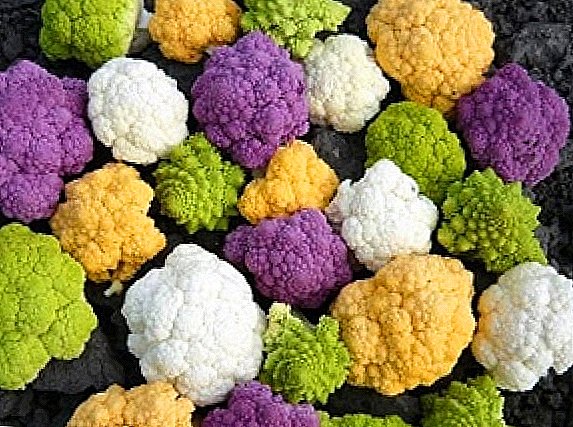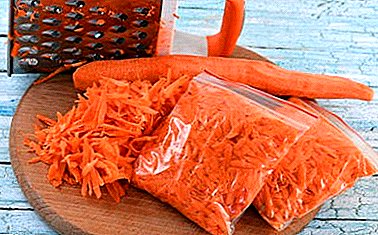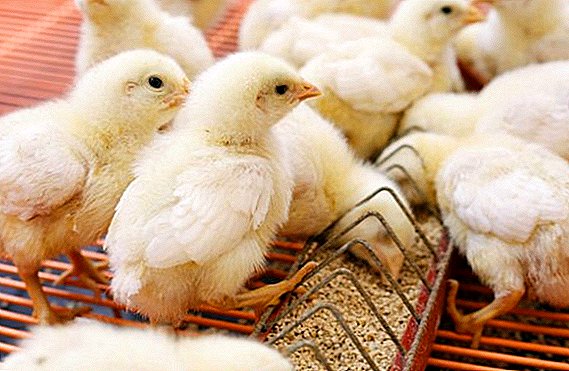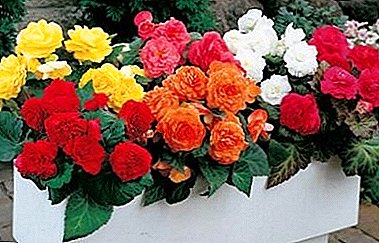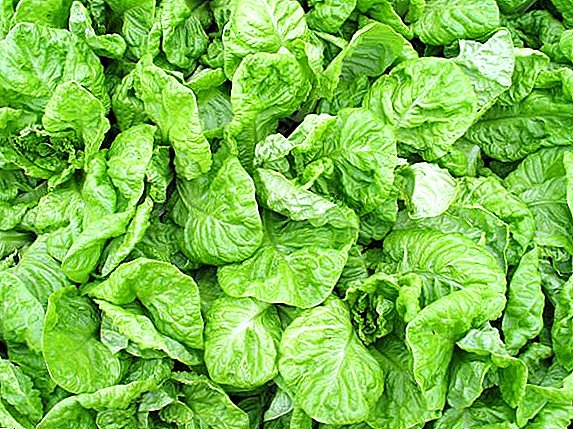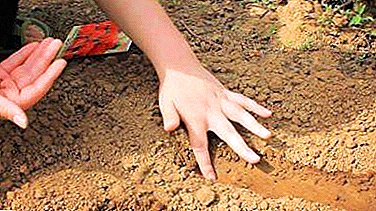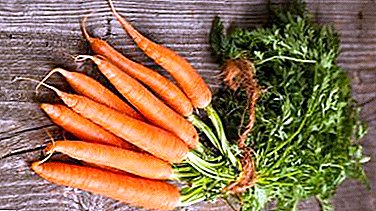
The varieties of carrots that are part of the Flacca variety are distinguished by their unpretentiousness, excellent taste and high yield. The article will describe in detail the features of carrots Flacca variety.
Find out what the Flacca carrot variety looks like, as well as all about the care and proper cultivation of the crop. We present to your attention a detailed description of carrots, as well as talk about the positive aspects and disadvantages of culture. In addition, you will learn about what distinguishes this variety of carrots from relatives.
Detailed description
Appearance
The form of root crops is tapered or spindle, pointed endThe surface is smooth, smooth. The taste of carrots is very sweet, crunchy. The core of the variety is large, orange. The length of the fruit varies in the range of 18-25 cm, and the diameter does not exceed 3.5 cm. The shade of the carrot is rich orange, sometimes with a reddish tint. The end of the root is not green.
Amount of fructose and beta carotene
This type is high in fructose and beta-carotene.
Sowing time and seed germination
Flacca is a late variety.. One of the main advantages of the variety is high seed germination rates.
The average weight of one fruit and yield
The average weight of one root - 120-190 g (gardeners who use this type for planting on their plots, claim that almost all root crops grow to 200 g). The yield per hectare is 350-550 c / ha.
What is meant for?
The grade is intended for the use in the fresh and processed looksuitable for long-term storage.
Growing regions
The variety is suitable for cultivation in many regions of the country, it grows well even in difficult climatic regions of Russia - the Urals and Siberia.
Where is recommended to plant?
Agronomists recommend growing Flacca carrots in the greenhouse and in the garden. You can plant a vegetable and at home, but do not have to wait for a big harvest. However, when grown in the Urals and in Siberia, it is better to still prefer greenhouses.
Resistance to diseases and pests and maturity
Flacca is a hybrid variety, therefore it is highly resistant to diseases and pests. The average time of ripening is from 100 to 120 days.
It is recommended to plant seeds from March to September and from October to November.
Suitable soil
The most suitable primer for carrots of the Flaccus variety group is black earth with a weak weight and low ash content. If the soil is very heavy and clogged, it is recommended to add a small amount of sand in it. And lime is well suited to reduce acidity (it is scattered in the amount of 50-80 g per square meter).
Frost resistance and transportability
Carrots will not survive severe frosts, but it will suffer light frosts. Therefore, it can be sown in March and even in November. Root vegetables must be stored at an average temperature of 10-13 degrees above zero. Flacca tolerates transportation. However, you need to transport only healthy fruits without rotting and mechanical damage.
Manufacturability for farms and peasant farms

The described variety is one of the most technologically advanced in farms and agricultural farms. This is explained by the fact that the use of additional measures is not required when growing carrots - it is enough to carry out standard agrotechnical procedures.
The large size, long storage period and high yields have made Flacca one of the most popular among farmers and agronomists. Carrots are suitable for cleaning in a mechanized way..
Varieties related to this type
- Flakkenaria;
- Flakke;
- Flakke Agroni;
- Rote Riesen (Red Giant);
- Kamaran F1;
- Krakow F1;
- Autumn King;
- Vita Long;
- Carotan;
- Queen of Autumn;
- Coltan F1;
- Victoria F1.
Breeding history
The variety type has been on the market relatively recently. Polish botanists were engaged in breeding - in this country gardeners had already managed to appreciate all the advantages of the hybrid produced.
What is the difference from other carrot varieties?
Main distinguishing features:
- high content of fructose and carotene;
- large fruits;
- high yield;
- presentable appearance.
Advantages and disadvantages

The advantages of the Flacca variety include the following characteristics:
- root crops do not accumulate nitrate substances in themselves, therefore they are widely used in cooking;
- high-level taste qualities (children love this carrot for its sweet taste);
- good transportability;
- long shelf life;
- unpretentiousness in cultivation.
Deficiencies in the variety is not revealed.
Growing up
Flacca is usually planted in March. But it is best to focus on the temperature of the air and the ground. The upper 10 cm should warm up to at least 10-12 degrees.
- Before planting, seeds are soaked for a day.
- Planted seeds in a pre-moistened soil.
- The wells are dug up to a depth of 5-6 cm, then they are shed with a small amount of water and the soaked seeds are placed in the ground. When you put the seeds in the wells, back off from the seeds of 2 centimeters. And between the rows, keep a distance of 20-25 cm.
Choose a landing site that is under the sun most of the day. The lack of coverage has a negative effect on yields.
The best predecessors for the Flacca carrot are:
- cucumbers;
- tomatoes;
- cabbage;
- bow;
- garlic;
- potatoes.
Care after germination

- After the first shoots appear, they will need to thin out. This is necessary in order to grow larger. About 2-3 cm of free distance should remain around each shoot.
- Watered carrots once a week. It is necessary to moisten the soil abundantly so that it is wet to the depth of 15 centimeters. The optimal time for watering is early in the morning or in the evening after sunset. In this case, the earth is well soaked and does not form a crust. 20 days before harvesting, watering stops.
- Do not forget to loosen the soil after watering - this is necessary so that air passes into the soil.
- To get a rich harvest, gardeners recommend fertilizing every two weeks. The best solution is nitrophoska. Approximate consumption - 5 liters per square meter.
Harvesting and Storage
Flacca can be planted both in spring and before winter. But keep in mind that only the one that was collected before winter will be suitable for storage. The rest is allowed to cook immediately.
Carrots planted in March are harvested from late August to the second half of September (preferably before the first frost). To harvest, choose a day without rain.
Once the roots are removed from the soil, lay them dryshaking off the ground. It must be a well ventilated place. Only the next day, you can add the harvest in boxes. Storage container must be dry and clean. Give preference to plastic and wooden boxes.
Crop is stored at a temperature of 12-14 degrees above zero. The basement is ideal for this. Check in advance for dampness, mold, and, if necessary, dispose of it. Air the basement.
Diseases and pests

Flacce variety is resistant to many diseases and pests. However, if agrotechnics are not observed, pests of the family of umbellate and white-winged pests can attack the carrots; The main ways to combat and prevent:
- disinfection of seed with a solution of potassium permanganate;
- selection of the correct site for landing (well lit and ventilated place without drafts);
- At the first signs of the appearance of diseases or pests, treat all fruits and tops with a soap-and-salt solution.
Various problems and solutions
- Thin root vegetables. Appear because of the dense planting of seeds. To avoid this problem, thin the carrots twice a season.
- Dry core. Appears due to rare or weak watering.
- Fruit softening. This happens if the fruit is over-watered during growing or stored in a room with high humidity.
- The appearance of shoots occurs in the case of storage in a warm room.
- Bitter taste. Appears if too much of the carrot is above the ground. To prevent the taste from spoiling, sprinkle with the ground even the edges of the roots.
Similar varieties
- Berlicum. It is similar to Flacca with taste, quantity of carotene, durability and shape of the root.
- Shantane. They are similar in content of fructose and beta-carotene, as well as the shape of the fruit.
- Dunvers. The similarity is manifested in the taste and appearance of carrots.
Excellent taste, long-term storage, high yields, as well as simplicity in cultivation made the carrot of Flacca cultivar one of the most common among farmers and agronomists. In addition, the variety is able to grow in almost all regions of the country.


